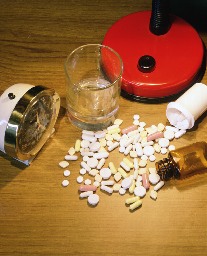Drugs the Cause of Most Deaths
One of Ellen White's favorite topics, besides the gospel, was healthful living. Here is what she had to say
in August 1864 about what she considered one of the most common causes of death:
|
I was shown that more deaths have been caused by drug-taking than from all other causes combined.
If there was in the land one physician in the place of thousands, a vast amount of premature mortality would
be prevented. Multitudes of physicians, and multitudes of drugs, have cursed the inhabitants of the
earth, and have carried thousands and tens of thousands to untimely graves.—Spiritual
Gifts, vol. 4a, p. 133, bold added.
|
 |
 |
| —Adam Hart-Davis/DHD Multimedia Gallery. |
|
Thus Ellen White believed that more than 50% of deaths were due to "drug-taking." Sound weird,
extreme, radical, and just plain off the wall? Not if you're a regular reader of
the Journal of the American Medical Association (JAMA). But before we quote from that
most prestigious of medical journals, let's explore just a little about what Ellen White meant by
"drug-taking."
It might seem to the modern reader that Ellen White was denouncing the use of
antibiotics, but they weren't discovered yet in 1864 when the above was published.
Instead, physicians of that bygone era resorted to such odd-sounding remedies as
"mercury, strychnine, arsenic," "opium," and tobacco, and these were among the drugs
Ellen White was referring to (Selected Messages, vol. 2,
pp. 278, 443, 445; Temperance, p. 63).
We thus might expect the situation to be better today than in Ellen White's day, given the fact
that medical science has progressed to the point that far fewer drugs contain mercury, strychnine,
and arsenic. In fact, one has to resort to homeopathy to get a dose of strycnine, aka nux vomica.
Thus it wouldn't surprise us if today's mortality statistics for drugs are lower than 50%.
But just how high are the statistics today? And what drugs should we consider in answering that question?
A careful perusal of Spiritual Gifts and other works indicates that Ellen
White, similar to modern authorities, classified tobacco, alcohol, and even tea and coffee
as drugs:
|
They become addicted to the use of wine and alcohol, tobacco and
opium, and go from one stage of debasement to another.—Temperance, p. 274.
I was shown that the innocent, modest-looking,
white poppy yields a dangerous drug. Opium is a slow
poison, when taken in small quantities.—Spiritual Gifts, vol. 4a, p. 138.
Tobacco, in whatever form it is used, tells upon the
constitution. It is a slow poison.—Spiritual Gifts, vol. 4a, p. 126.
Tea and coffee are stimulating. Their effects are
similar to those of tobacco; but they affect in a less
degree. Those who use these slow poisons . . . .—Spiritual
Gifts, vol. 4a, p. 128.
Nature does her best to expel the poisonous drug, tobacco;
but frequently she is overborne.—Healthful Living, p. 109.
Under the influence of the drink they take, they are led to do things from which, if they
had not tasted the maddening drug, they would have shrunk in horror. When they are under
the influence of the liquid poison, they are in Satan's control.—Temperance, p. 24.
[The physician] is called to attend young men and men in the prime of life and in mature age,
who have brought disease upon themselves by the use of the narcotic tobacco.—Counsels
on Health, p. 322.
. . . if I liked wine, tea, and coffee, I would not use
these health-destroying narcotics . . . .—Selected
Messages, vol. 2, p. 302.
|
Therefore, when comparing today's mortality statistics with Ellen White's statement that "more deaths have
been caused by drug-taking than from all other causes combined," we should include deaths from
alcohol and tobacco.
The Cause of About 25% of Deaths
The March 10, 2004 issue of JAMA carried a very interesting study by Mokdad et. al.
entitled, "Actual Causes of Death in the United States, 2000." Out of 2.4 million deaths that year,
the following were listed as among the causes of death:
| Cause of Death |
Estimated Range |
Estimated Number |
% of Total Deaths |
| Tobacco |
Not Given |
435,000 |
18.1% |
| Alcohol consumption |
70,808 to 140,000 |
85,000 |
3.5% |
| Illicit drug use |
Not Given |
17,000 |
0.7% |
|
The above numbers indicate that roughly 25% of fatalities in the year 2000 were due to tobacco,
alcohol, and illicit drugs. While that's a huge chunk of the >50% figure Ellen White referred to,
it isn't >50%. But then, we've got a number of other studies to look at.
Properly Adminstered Drugs
Quite remarkable was the report by John Hopkins' Dr. Barbara Starfield in the July 26, 2000
issue of JAMA. This report ("Is US Health Really the Best in the World?") expressed concern
that U.S. health falls way behind other industrialized nations. It
summarized death rates from several causes in the following way:
| Cause of Death |
Estimated Number |
| Nonerror, adverse effects of medications |
106,000 |
| Nosocomial infections in hospitals |
80,000 |
| Other errors in hospitals |
20,000 |
| Unnecessary surgery |
12,000 |
| Medication errors in hospitals |
7,000 |
|
 |
| —Adam Hart-Davis/DHD Multimedia Gallery. |
|
 |
Thus we have a modern, medical authority telling us that, despite today's much rarer use of
mercury, strychnine, and arsenic in medicines, we still have at least 113,000 (106,000 + 7,000)
deaths a year due to medicinal drugs, with 93.8% of that number involving no errors
whatsoever. In other words, nearly 1 out of every 20 people who die in the United States each year
die as a result of a medicinal drug they receive.
Why the Numbers Could Be Higher
When we examine the study that Dr. Starfield based her 106,000 figure on, we discover that
the picture may be better or worse than that. According to Lazarou et. al. in "Incidence of Adverse
Drug Reactions in Hospitalized Patients," deaths in hospitals due to properly prescribed and properly
administered drugs range from 76,000 to 137,000 (JAMA, Apr. 15, 1998). 106,000 was but the
average of these two numbers.
Lazarou's study only considered serious Adverse Drug Reactions (ADRs) in its calculations, and excluded
events considered to be possible ADRs. It also excluded events "caused by errors in administration, noncompliance,
overdose, drug abuse, or therapeutic failures."
The study defined a serious ADR as "an ADR that requires
hospitalization, prolongs hospitalization, is permanently disabling, or results in death." One can imagine
that a serious ADR that was permanently disabling rather than fatal this year could be a contributing factor
toward death in later years. This consideration would make Ellen White's statistics higher than those of
Lazarou et. al., since she does not specify that the drugs have to cause death immediately.
"Organ Failure"
Another reason why her statistics might be higher is explained by Dr. Starfield:
|
. . . currently, most deaths resulting from these underlying causes are likely to be coded
according to the immediate cause of death (such as organ failure).—"Is
US Health Really the Best in the World?" JAMA, July 26, 2000, p. 484.
|
In other words, since most fatalities are likely blamed on the patient's organ failure
rather than on the drugs they were taking that caused the organ failure, Dr. Starfield contends
that we really don't know how many people are dying each year because of prescription drugs.
And this problem is a global one, for at least in Ireland, "less than 10% of all serious" ADRs get reported
(National Medicines Information Centre, vol. 8, num. 3 (2002), p. 3).
Yet another reason why Ellen White's statistics might be higher is the fact that Lazarou's study only
considered deaths due to drugs in hospitalized patients, whereas she was referring to everyone, whether
outpatient or inpatient.
The various types of ADRs Lazarou et. al. gave were as follows:
| Type of Serious ADR |
Estimated Range of Serious ADRs |
Estimated Number of Serious ADRs |
Estimated Range of Fatalities |
Estimated Number of Fatalities |
| Resulted in a hospital admission |
1,033,000 to 2,060,000 |
1,547,000 |
15,000 to 71,000 |
43,000 |
| Occurred in the hospital |
635,000 to 770,000 |
702,000 |
41,000 to 85,000 |
63,000 |
| Totals |
1,721,000 to 2,711,000 |
2,216,000 |
76,000 to 137,000 |
106,000 |
|
Thus, even given the fact that "most deaths resulting from
these underlying causes are likely to be coded according to the
immediate cause of death (such as organ failure)," Lazarou still concludes that
"fatal ADRs ranked between the fourth and sixth leading cause of death in the United
States in 1994."
 |
 |
| —Adam Hart-Davis/DHD Multimedia Gallery. |
|
Aren't They Tested?
How can this be, given the fact that new drugs are routinely tested so well?
Maryann Napoli of the Center for Medical Consumers explained some of the reasons why in her testimony
before the "Meeting of the Institute of Medicine's (IOM's) Committee on the Assessment of the US Drug
Safety System," a meeting that occurred on July 19, 2005.
Mrs. Napoli explained that drug companies sponsor the trials that test the drugs, and thus are responsible
for the reports that get published in "high-profile medical journals." (Sound like a possible conflict of
interest?) While those reports describe supposed benefits quite well, they frequently omit key data
regarding ADRs. For example, in men, statin drugs are supposed to lower the risk of non-fatal heart attacks
by 1.8%, yet the reality is that that 1.8% lower risk is accompanied by a 1.4% increased risk of death,
significant disability, hospitalization, or a life-threatening event. Moreover, 60% of the trials being reviewed
refused to turn over their "serious adverse events" data, thus making it impossible to know really how
beneficial or detrimental these drugs really are.
It isn't as if Ms. Napoli's concerns are new. Back in 2001 John P. A. Ioannidis, MD and Joseph Lau, MD
had this to say after looking at 192 randomized drug trials:
|
Results Severity of clinical adverse effects and laboratory-determined
toxicity was adequately defined in only 39% and 29% of trial
reports, respectively. Only 46% of trials stated the frequency
of specific reasons for discontinuation of study treatment due
to toxicity. . . . Overall, the median space allocated
to safety results was 0.3 page. A similar amount of space was
devoted to contributor names and affiliations . . . .
Conclusions The quality and quantity of safety reporting vary
across medical areas, study designs, and settings but they are
largely inadequate. Current standards for safety reporting in
randomized trials should be revised to address this
inadequacy.—"Completeness
of Safety Reporting in Randomized Trials," JAMA, Jan. 24, 2001.
|
29%, 39%, and 46%. That's not real good considering that people's lives are at stake.
Rat Poison a Common Cause of ADRs
An advisory committee for the University of Iowa Hospitals and Clinics has a
Pharmacy and Therapeutics Subcommittee, which puts out periodic newsletters. One of those newsletters
had this to say:
|
. . . the nine most frequently reported agents associated with an adverse drug reaction were: warfarin,
phenytoin, levofloxacin, vancomycin, morphine, amiodarone, IVIG, nafcillin, and
tirofiban.—P&T
News, May 2003.
|
Warfarin (aka Coumadin), the first drug on the above list, has been a common ingredient in rat poison for a long time. A
common anti-coagulant, it causes rats and mice to bleed internally, which then makes them thirsty, which
then makes them head out of doors to find water. Since they end up dying outside instead of in your house,
your house smells better, and that's why it's been so popular in rat poison.
Unfortunately for a lady we visited in the hospital in early 2006, she had been given warfarin,
without adequately monitoring her blood to make sure her clotting ability
had not dropped too far. It's absolutely essential that anyone taking Coumadin be carefully monitored, but
this lady wasn't. She ended up bleeding inside her skull, and was in ICU when we saw her. She nearly died.
Ellen White's Alternative
Okay, so what did Ellen White advocate using instead of all these drugs?
|
Pure air, sunlight, abstemiousness, rest, exercise, proper
diet, the use of water, trust in divine power—these are the
true remedies. Every person should have a knowledge of
nature's remedial agencies and how to apply them.—Counsels on Health p. 90.
In the Saviour's manner of healing there were lessons for His
disciples. On one occasion He anointed the eyes of a blind man with clay,
and bade him, "Go, wash in the pool of Siloam. . . . He went his way
therefore, and washed, and came seeing." John 9:7. The cure could be
wrought only by the power of the Great Healer, yet Christ made use of
the simple agencies of nature. While He did not give countenance to
drug medication, He sanctioned the use of simple and natural
remedies.—Desire of Ages, p. 824.
|
Give Us Your Opinion
| Is Ellen White right about drugs causing so many deaths? |
| Yes, I think she is right. For some time now I've thought that natural remedies were the way to go. |
 88.0% 88.0% |
| There's no way she can possibly be right. Quite scaring people. It could hurt the economy. |
 5.6% 5.6% |
| Maybe she is, since the Journal of the American Medical Association seems to support what she said. |
 4.0% 4.0% |
| I don't know. I've never heard this before. I didn't know so many medical professionals felt this way. |
 2.4% 2.4% |
Total Votes: 125
|
|
|


